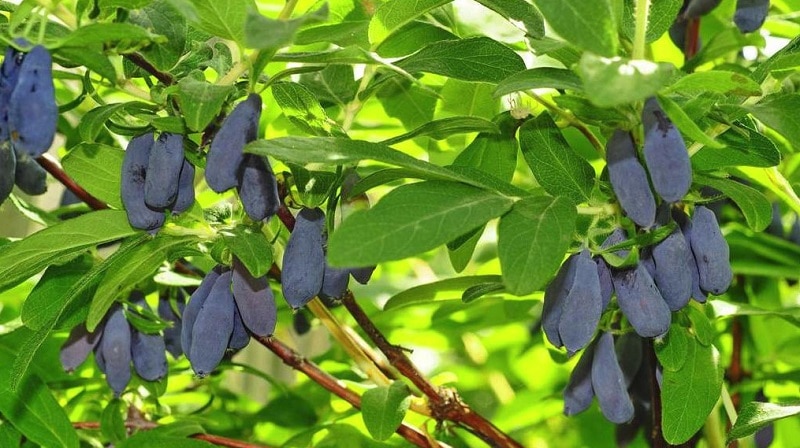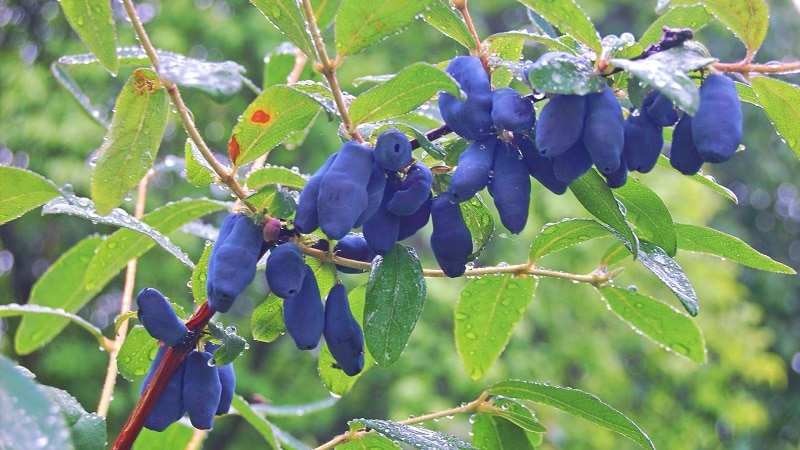How to effectively increase your honeysuckle yield
After planting honeysuckle, many gardeners are dissatisfied with its yield, even if they followed all the recommendations on agricultural technology. The reason lies in illiterate care and ignoring the advice of experienced summer residents. There are several basic rules aimed at stimulating honeysuckle fruiting. How to increase your harvest 10 times, read our article.
Yield rate of honeysuckle per bush
The average yield of honeysuckle is 1-1.5 kg of berries per bush. In Siberia and the Far East, the maximum yield is 7-10 kg of fruit per plant. In the European part, 5 to 12 kg of berries are collected from a bush. This indicator depends on the variety.
Reference. An adult plant with proper care produces a good harvest of berries. In this case, the weight of one fruit reaches 1.5-2.5 g.
How to increase honeysuckle yield - methods
The following methods are aimed not only at improving yields, but also solving related problems with honeysuckle: survival rate, growth and development.

Selection of productive varieties
Planting new highly productive varieties - guarantee of obtaining the desired harvest. Such plants include honeysuckle Amazon, Long-fruited, Maria, Elizaveta 3, Zarechnaya, Lenita. The last variety was bred by breeders from Chelyabinsk. Recently it has become popular, since one bush annually produces from 10 to 12 kg of berries.
Before purchasing varieties, take into account ripening period, planting region and growing tips. Otherwise, honeysuckle will not delight you with delicious berries.
Planting different varieties for cross-pollination
Gardeners make a grave mistake when they plant 1 or 3 bushes in one area. Honeysuckle bears fruit, but does not produce a good harvest. Experienced summer residents increase the number of bushes to 10, sometimes up to 15. The plants are in perfect harmony with each other, delighting with a good harvest of large and sweet berries.
Important! New ones appear every year varieties of honeysuckle, so the choice does not cause any particular difficulties. For example, the Bakchar giant is considered the best pollinator for honeysuckle Pride of Bakchar, Silginka, Chulymskaya.
Planting honeysuckle in an open, sunny area
To speed up the fruiting of honeysuckle, it is important to choose the right one growing place. In partial shade, the indicators sharply decrease, since the plant is in a state of constant oppression, and poor formation of reproductive buds is observed. It is easy to replant small bushes: they have a compact, fibrous root system.
Attracting Pollinators
The quality of fruit set depends on the availability pollinating insects and weather conditions during the flowering period.
How to increase the yield of honeysuckle in the country:
- Bees pollinate the plant well. Experienced gardeners choose planting sites where there are large concentrations of bumblebees.
- Honeysuckle is planted exclusively in clumps, and not in a row, like raspberries. This way pollinators better navigate between the bushes and fly around each flower.
- Attract insects by spraying plants at the beginning of flowering. To do this, prepare a solution of honey and sugar: 2 tbsp. l. dissolve in 10 liters of water. Spraying is carried out 2-3 times, only in the morning, in dry and windless weather.
- To stimulate fruit formation, the bushes are sprayed with “Ovary” or “Bud” preparations at the beginning of flowering.They do this to replace a previous event when the weather is cool and windy.
- During the budding period, spray with a tank mixture of “Zircon” (1 ampoule is dissolved in 10 liters of water) and “Cytovit” (2 ampoules or 3 ml are mixed in 10 liters of water).
Selection of fertile soil
Although honeysuckle growing on almost all soils; it bears fruit well only on light, fertile and breathable soils. If there are no such conditions on the site, summer residents provide them within the planting hole.
How to improve fruiting:
- Always prepare a pit measuring at least 60x40 cm and 50-60 cm deep.
- Add 1-2 buckets of humus, 1 liter of wood ash, 30-50 g of complex mineral fertilizers (sold dry in garden stores), 2 handfuls of organomineral fertilizer. The latter is a biofertilizer with soil microorganisms. They suppress pathogenic microflora and quickly digest any organic matter.
- To improve the soil structure and moisture capacity, add 3-5 liters of vermiculite. If possible, add sand, peat, and dolomite flour.
This composition of fertilizers really increases the yield of honeysuckle, improves the quality of the berries and at the same time helps to improve the health of the soil.
Compliance with the planting pattern
Before placing shrubs, take into account that they will grow on the site for about 25 years. A distance of 1.5-2 m is maintained between plants, and 2-2.5 m between rows.
The free planting scheme makes it easier to care for seedlings. The gardener goes around the bush from all sides, without touching the branches with buds and berries.

Maintain regular and abundant watering and spraying
The yield of honeysuckle is largely depends on care during the period of ripening and filling of berries, therefore gardeners adhere to the following rules:
- in May and June, 5 good waterings are carried out, spending 4-5 liters of water per bush;
- at the same time, the plants are sprayed with stimulants and growth regulators, biological products (for example, “Biosil”);
- During the fruiting period, protect the bushes with various repellents (netting, special structures) so as not to lose the harvest.
Freeing honeysuckle from excess vegetation
The peculiarity of this berry crop is the high rate of shoot formation, which leads to rapid thickening of the bush. In early spring, summer residents carry out annual thinning honeysuckle pruning aged 4-5 years. Remove diseased, dry, broken branches.
Attention! Pruning promotes better penetration of pollinating insects into the inner part of the bush, where intensive development of buds is observed.
Is it possible to increase the sweetness of berries and how to do it
If the sweetness of the berries becomes the only goal when growing honeysuckle, the gardener should choose the appropriate varieties. Thus, Slavyanka, Daughter of the Giant and Cupid do not have sourness and slight bitterness, and are characterized by large fruits.
Lack of moisture in the soil causes characteristic bitterness in the fruit, so honeysuckle is watered up to 10 times throughout the season. Do not forget about foliar and root feeding. For these purposes, complex fertilizers “Tsitovit”, “Uniflor Micro”, “Florist Micro” are chosen. Follow the instructions for use.
Conclusion
Honeysuckle is a high-maintenance plant.To increase productivity and improve the quality of fruits, you should choose a suitable location, properly prepare the soil, take into account the planting scheme, attract pollinators, and avoid thickening of the bushes. Be sure to follow the watering rules and spray in a timely manner. After 1-2 years, honeysuckle will begin to delight you with an abundant and sweet harvest.